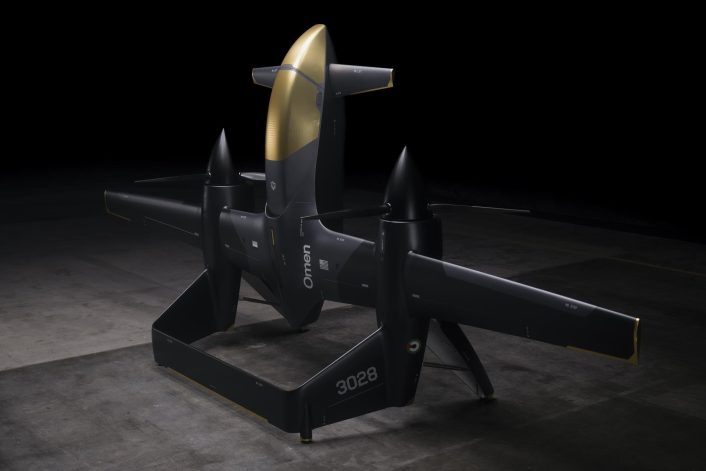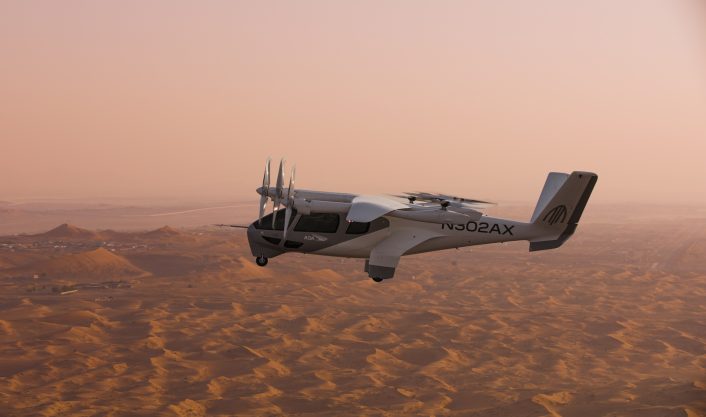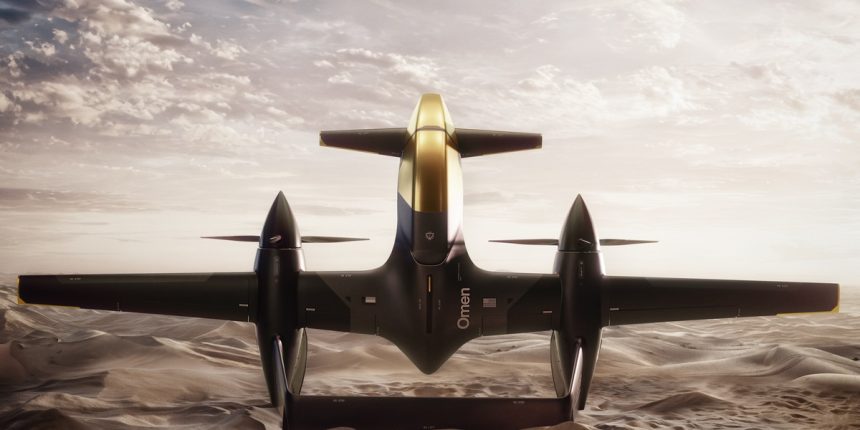Anduril previously said a breakthrough in Omen’s development came through collaboration with Archer Aviation, which develops hybrid-electric VTOL systems.
Archer Aviation has announced on Nov. 17, 2025, that it will supply its proprietary hybrid powertrain to third parties, starting with the Omen drone being developed by Anduril and Edge Group. The drone was recently unveiled as a new hover-to-cruise, runway-independent Autonomous Air Vehicle (AAV) that the partners say combines the endurance and payload of much larger aircraft with the logistics simplicity of a compact Group-3 platform.
Following Omen’s presentation, Anduril admitted its engineers faced propulsion limits on a demonstrator tested in 2019, reported Aviation Week. Anduril executives told reporters that a breakthrough came through work on hybrid propulsion concepts and collaboration with Archer Aviation, which develops hybrid-electric VTOL systems.
For almost a year, we’ve worked closely with @PalmerLuckey, @SchimpfBrian and Shane Arnott’s team at @anduriltech as we advance our hybrid-electric aircraft project. As we’ve familiarized ourselves with each other’s technology, we’ve unlocked new and interesting opportunities to… pic.twitter.com/Pv2sAib5XK
— Adam Goldstein (@adamgoldstein13) November 17, 2025
In the press release, Archer says the agreement marks the first time the company will make its proprietary, advanced powertrain technology, in use on its Midnight eVTOL aircraft, available for use by a third party. The company noted that the powertrain is highly optimized for a range of commercial and defense aviation use-cases.
The Agreement
Archer says it is expanding its business lines to supply electric powertrains for defense applications, opening “a new, high upside revenue stream for the company.” Moreover, the company says its dual use electric powertrain technology will allow to accelerate the development and scaled production of Omen.

The parties did not disclose the details of the collaboration, with Archer only generically mentioning the powertrain. Aviation Week reported, following an interview with the company’s officials, that the battery pack is an integral part of that offering, as well as motor and rotor systems.
“While most see our Midnight eVTOL as an aircraft, we view Midnight as a platform that plays host to a wide range of new and exciting aerospace technologies that will be leveraged way beyond our own aircraft. Our powertrain deal with Anduril is the first of what we expect to be many examples of this.”
— Adam Goldstein, founder and CEO of Archer.
Goldstein further noted that Archer worked closely with Anduril for almost a year and they familiarized themselves with each other’s technology. This allowed to uncover “new and interesting opportunities to collaborate beyond the scope of the initial hybrid aircraft project.”
“We could not be more excited to expand the scope of our partnership with Anduril as we open up a new revenue stream for Archer’s business as a powertrain supplier for next-generation electric aircraft,” added Goldstein.

Shane Arnott, Anduril’s Senior Vice President Programs & Engineering, noted how the combination of both companies’ expertise allowed to reach the requirements’ goal for Omen.
“We’ve been working on Omen for more than five years. By combining the Archer team’s expertise in powertrain technology with a little bit of Anduril magic, we’ve been able to mature our propulsion solution to achieve the ranges, speeds, and payload capacity we need to make Omen operationally relevant for a variety of dual-use mission sets. The maturity and reliability of Archer’s powertrain platform de-risks our plans to deliver a production variant of Omen to customers at scale.”
— Shane Arnott, Senior Vice President Programs & Engineering at Anduril
Omen AAV
Anduril Industries and UAE state-owned EDGE Group have announced a production alliance to field Omen on Nov. 13, 2025. The system is described as a new hover-to-cruise, runway-independent Autonomous Air Vehicle (AAV) that the partners say combines the endurance and payload of much larger aircraft with the logistics simplicity of a compact Group-3 platform.
Omen is not just a concept.
Anduril started building Omen in 2019, flew the first Omen demonstrators in 2020, and has logged hundreds of flight hours across 30+ prototypes.
Today, Omen is the first tail-sitter airplane with a mass-production contract. pic.twitter.com/QmzlALpbBY
— Anduril Industries (@anduriltech) November 14, 2025
The announcement, formalized in the EDGE–Anduril Production Alliance, includes an initial UAE purchase of 50 systems and a plan to take the aircraft into full-rate production by the end of 2028. The two companies will also establish local production, sales and sustainment in the UAE, with an in-region, 50,000-square-foot Research & Development and virtual-simulation center to support engineering, integration and testing.
Omen is designed as a tailsitter, able to take off and land vertically while resting on its tail, transitioning to conventional, airplane-style cruise flight once in the air. Anduril describes it as “a hover-to-cruise Autonomous Air Vehicle (AAV) that packs the endurance, payload, and mission flexibility of much larger airplanes into a novel runway-independent group 3 platform.”
I am so happy to be able to finally show this. We started the Omen project in 2019, and candidly, the specs required trapped it in development hell. Five full-scale redesigns and six years later, it finally works.
Dev video coming soon with a mix of flying and crashing. https://t.co/H4tPBOKgGP
— Palmer Luckey (@PalmerLuckey) November 13, 2025
The design features what has been described as sailplane-style wings, canards, and twin-boom nacelles that feed into a high horizontal tail, says Aviation Week. The configuration is intended to deliver the cruise efficiency of a fixed-wing machine while preserving a VTOL ability to operate from decks, beaches or austere clearings without runways.
Anduril says Omen collapses to less than half its assembled size and can be unpacked, assembled and launched by a two-person team in minutes, and is thus explicitly optimized for low-logistics expeditionary use. Additionally, the company says the drone can easily and rapidly swap payloads, from EO/IR gimbals to advanced sensing, communication, and effects-enabling systems.
Early Omen transition testing didn’t always go to plan when we relied on COTS autopilots. In this incident, the software flipped from ‘hover mode’ to ‘airplane mode’ before the vehicle was fast enough to cruise like one – compounded by a propulsion/rotor droop that kicked off the… https://t.co/AscxYphcH9 pic.twitter.com/H0BHxLexiA
— Anduril Industries (@anduriltech) November 14, 2025
Propulsion and Funding
Development of Omen has been underway for several years, however Anduril’s engineers faced propulsion limits on a demonstrator tested in 2019, reported Aviation Week. Anduril executives told reporters that a breakthrough came through work on hybrid propulsion concepts and collaboration with Archer Aviation.
Judging by the renderings released with the announcement of the joint venture, the powerplant will likely feature a thermal engine in a central location, where an air inlet is located (behind a fake cockpit), with electric motors in the nacelles on which the propellers are installed.
Anduril is building a 50,000-sq-ft R&D facility in Abu Dhabi, our first operational footprint in the Middle East.
The UAE has finalized an acquisition of 50 Omen systems, creating a guaranteed production base.
Delivering these capabilities to the Gulf will accelerate critical… pic.twitter.com/4aQJPxBKkE
— Anduril Industries (@anduriltech) November 13, 2025
Anduril has stated that it has invested roughly $850 million of its internal funds in autonomy and Group-3 VTOL development, including also the funding used by Omen. EDGE will provide about $200 million for joint development and local manufacturing capacity in the UAE.
Explaining the reasons for the long development time for Omen, Anduril’s founder Palmer Luckey said “the specs required trapped it in development hell.” Moreover, he also noted that five full-scale redesigns were required before finalizing the current configuration.
Archer’s Expansion in the Middle East
On Nov. 13, Archer announced “the successful completion of an in-country eVTOL flight test campaign, showcasing Midnight’s full eVTOL flight envelope – including vertical takeoff, transition, and wingborne flight – in the UAE’s local operating environment and over desert areas.” The company said this “marks a major step forward in the implementation of Abu Dhabi’s Advanced Air Mobility (AAM) vision,” as it works to expand into the United Arab Emirates and make Abu Dhabi the first region in the world to begin commercial operations with Midnight.

The company is working on multiple fronts, hosting the UAE’s General Civil Aviation Authority (GCAA) at its Headquarters in San Jose, California, to continue to accelerate the regulatory pathway and working alongside Etihad Aviation Training to advance pilot training. Archer says the effort “complements Abu Dhabi’s recent announcement to develop an emirate-wide air taxi network of over 10 vertiport sites, under the supervision and coordination of the Integrated Transport Centre.”
“We designed Midnight to be able to handle challenging weather environments like the UAE with its sand and heat, and it delivered the results we expected it to across all phases of flight,” said Adam Goldstein, Archer’s Founder and CEO. “Our ‘Launch Edition’ program has proven to be an effective framework to help accelerate Archer and our partners’ progress toward commercialization in Abu Dhabi and the rest of the UAE.”
On Nov. 19, Archer announced an agreement with the Helicopter Company (THC), Saudi Arabia’s premier commercial helicopter operator, signed at this year’s Dubai Airshow. The partnership will focus on the development, testing, and potential integration of Archer’s eVTOL aircraft into Red Sea Global’s (RSG) operations as one of the first deployments of eVTOL aircraft in the Kingdom of Saudi Arabia.

In the initial phase of the agreement, Archer Aviation will work together with THC and RSG to help build the foundational framework for their planned eVTOL operations in Saudi Arabia. RSG will then lead the sandbox testing with Archer’s Midnight aircraft to evaluate the potential for integrating eVTOL aircraft into the company’s future operations.
Goldstein commented, “A key part of Archer’s strategy is partnering with the leading operators in each country who share our goals and vision, and both THC and RSG are similarly committed to ensuring that Saudi Arabia is operationally prepared to launch eVTOL aircraft. We look forward to working together to demonstrate how Archer’s Midnight aircraft can transform travel within the Kingdom and set a regional benchmark for the future of aviation.”









